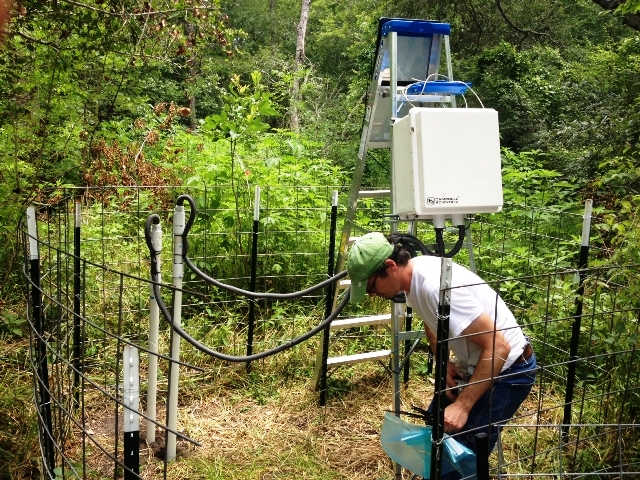Baylor University Scientists Build Database for More Accurate and Efficient Soil-based Climate Reconstruction

Researchers install sensors at research site
Follow us on Twitter: @BaylorUMediaCom
Contact: Frank Raczkiewicz, (254) 710-1964
WACO, Texas (Aug. 21, 2012) - Baylor University scientists are developing a soils database that will help geologists and soil scientists to more quickly and accurately analyze data from fossilized soils to determine and reconstruct ancient climates.
"Research in ancient climates recorded in the geologic past provides us with our only means of testing climate models for the future, particularly the anticipated climate change that would be brought about by increased anthropogenic emissions of greenhouse gases such as carbon dioxide and methane," reported Steven Driese, Ph.D., professor and chair of the geology department at Baylor University's College of Arts & Sciences.
Geologists and soil scientists face a data overload problem due to numerous global and continental-based soil geochemical databases becoming more widely available, according to Driese.
"The overwhelming nature of available data makes ancient climate construction difficult and time consuming," he said. "Accurate and easily accessible data can help build more reliable models."
Driese reported on the new database, currently still in the development phase, at the recent meeting of the International Goldschmidt Conference on Geochemistry in Montreal.
Researchers Examining Ancient Soil for Insight into Climate Change -->
Called the Baylor University Paleosol Informatics Cloud (BU-PIC), it combines soil, climate, topography, and vegetation data from the U.S Department of Agriculture (USDA), the PRISM (Parameter-elevation Regressions on Independent Slopes Model) Climate Group, the National Land Cover Database (NLCD) and peer reviewed journals.
The database is fully searchable and can be queried using various whole-soil and geochemical parameters to predict specific ancient climate conditions.
Post-doctoral student Gary Stinchcomb, Ph.D., working with Driese and Lee Nordt, Ph.D., professor and dean of the College of Arts and Sciences, will present further improvements and a test of the database at the Annual Meeting of the Geological Society of America in Charlotte, N.C. in November 2012.
ABOUT BAYLOR UNIVERSITY
Baylor University is a private Christian university and a nationally ranked research institution, characterized as having "high research activity" by the Carnegie Foundation for the Advancement of Teaching. The university provides a vibrant campus community for approximately 15,000 students by blending interdisciplinary research with an international reputation for educational excellence and a faculty commitment to teaching and scholarship. Chartered in 1845 by the Republic of Texas through the efforts of Baptist pioneers, Baylor is the oldest continually operating university in Texas. Located in Waco, Baylor welcomes students from all 50 states and more than 80 countries to study a broad range of degrees among its 11 nationally recognized academic divisions. Baylor sponsors 19 varsity athletic teams and is a founding member of the Big 12 Conference.
ABOUT BAYLOR COLLEGE OF ARTS AND SCIENCES
The College of Arts & Sciences is Baylor University's oldest and largest academic division, consisting of 26 academic departments and 13 academic centers and institutes. The more than 5,000 courses taught in the College span topics from art and theatre to religion, philosophy, sociology and the natural sciences. Faculty conduct research around the world, and research on the undergraduate and graduate level is prevalent throughout all disciplines.